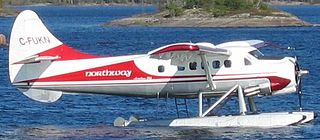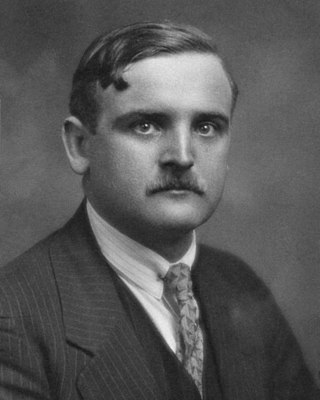
The Royal Flying Corps (RFC) was the air arm of the British Army before and during the First World War until it merged with the Royal Naval Air Service on 1 April 1918 to form the Royal Air Force. During the early part of the war, the RFC supported the British Army by artillery co-operation and photographic reconnaissance. This work gradually led RFC pilots into aerial battles with German pilots and later in the war included the strafing of enemy infantry and emplacements, the bombing of German military airfields and later the strategic bombing of German industrial and transport facilities.

A seaplane is a powered fixed-wing aircraft capable of taking off and landing (alighting) on water. Seaplanes are usually divided into two categories based on their technological characteristics: floatplanes and flying boats; the latter are generally far larger and can carry far more. Seaplanes that can also take off and land on airfields are in a subclass called amphibious aircraft, or amphibians. Seaplanes were sometimes called hydroplanes, but currently this term applies instead to motor-powered watercraft that use the technique of hydrodynamic lift to skim the surface of water when running at speed.

The Royal Naval Air Service (RNAS) was the air arm of the Royal Navy, under the direction of the Admiralty's Air Department, and existed formally from 1 July 1914 to 1 April 1918, when it was merged with the British Army's Royal Flying Corps to form the Royal Air Force (RAF), the world's first independent air force.
The history of the Royal Canadian Air Force begins in 1914, with the formation of the Canadian Aviation Corps (CAC) that was attached to the Canadian Expeditionary Force during the First World War. It consisted of one aircraft that was never called into service. In 1918, a wing of two Canadian squadrons called the Canadian Air Force (CAF) was formed in England and attached to the Royal Air Force, but it also would never see wartime service. Postwar, an air militia also known as the Canadian Air Force was formed in Canada in 1920. In 1924 the CAF was renamed the Royal Canadian Air Force (RCAF) when it was granted the royal title by King George V. The RCAF existed as an independent service until 1968.
This is a list of aviation-related events from 1920:
This is a list of aviation-related events from 1914.
In military aviation, a wing is a unit of command. In most military aviation services, a wing is a relatively large formation of planes. In Commonwealth countries a wing usually comprises three squadrons, with several wings forming a group. Each squadron will contain around 20 planes.

The Aviation Section, Signal Corps, was the aerial warfare service of the United States from 1914 to 1918, and a direct statutory ancestor of the United States Air Force. It absorbed and replaced the Aeronautical Division, Signal Corps, and conducted the activities of Army aviation until its statutory responsibilities were suspended by President Woodrow Wilson in 1918. The Aviation Section organized the first squadrons of the aviation arm and conducted the first military operations by United States aviation on foreign soil.

The Canadian Air Force (CAF) was a contingent of two Canadian air force squadrons – one fighter and one bomber – authorized by the British Air Ministry in August 1918 during the close of the First World War. The unit was independent from the Canadian Expeditionary Force and the Royal Air Force (RAF).

The Royal Flying Corps Canada was a training organization of the British Royal Flying Corps located in Canada during the First World War. It began operating in 1917.

Henry Aloysius Petre, DSO, MC was an English solicitor who became Australia's first military aviator and a founding member of the Australian Flying Corps, the predecessor of the Royal Australian Air Force. Born in Essex, Petre forsook his early legal career to pursue an interest in aviation, building his own aeroplane and gaining employment as an aircraft designer and pilot. In 1912, he answered the Australian Defence Department's call for pilots to form an aviation school, and was commissioned as a lieutenant in the Australian Military Forces. The following year, he chose the site of the country's first air base at Point Cook, Victoria, and established its inaugural training institution, the Central Flying School, with Eric Harrison.

The Dunne D.8 of 1912 was a tailless swept wing biplane, designed by J. W. Dunne to have inherent stability. One example was supplied to RAE Farnborough. License-built Burgess-Dunne models were used by the US Signal Corps and United States Navy and the short-lived Canadian Aviation Corps. It was the latter's first and only warplane.

A squadron in an air force, or naval or army aviation service, is a unit comprising a number of military aircraft and their aircrews, usually of the same type, typically with 12 to 24 aircraft, sometimes divided into three or four flights, depending on aircraft type and air force.

The history of aviation in Canada begins with the first manned flight in a balloon at Saint John, New Brunswick in 1840. The development of the aviation industry in Canada was shaped by the interplay of Canadian national ambitions, national and international politics, economics, and technology. Experimental aviation started in Canada with the test flights of Bell's Silver Dart in 1909, following the epochal flight of the Wright Brothers in 1903. The experimental phase gave way to use of aircraft in warfare. Many Canadians served in the British Royal Flying Corps and Royal Air Force during the First World War.
John Ender Palmer was a Canadian soldier of the First World War, awarded the Distinguished Conduct Medal, and a Canadian aviator.
Leutnant Emil Meinecke was a German flying ace during World War I. He was credited with six confirmed aerial victories. After the war, he stayed in aviation, rising to the post of chief test pilot for Fokker. His post there ended with Germany's defeat in World War II. Meinecke then returned to his trade as an aircraft mechanic during the Berlin Airlift. He eventually became a Canadian citizen in 1950.

Ernest Lloyd Janney (1893–1941) was the Provisional Commander of the Canadian Aviation Corps between 1914 and 1915. Janney pushed for the establishment of a Canadian flying corps during the First World War.

The Imperial Gift was the donation of aircraft from surplus stocks in Britain after World War I to the dominions of the British Empire: Canada, Australia, New Zealand, South Africa and India. On 29 May 1919, the Cabinet of the United Kingdom agreed to give 100 aircraft to the dominions in addition to replacements for aircraft donated to Britain during the war. These aircraft formed the core of newly established air forces in several dominions.
Lieutenant William Frederick Nelson Sharpe - pilot. Sharpe later joined the Royal Flying Corps but was killed in a flying accident. He was the first Canadian pilot to die in World War I.













